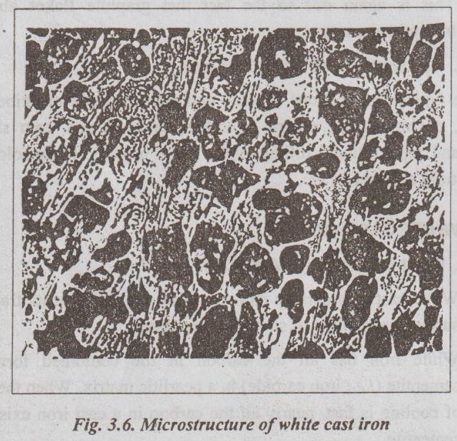White cast iron derives its name from the fact that its fracture surface has a white or silvery appearance.
WHITE CAST IRON
1. What is Meant by White Cast Iron?
✓ White cast iron derives its name from the fact that its fracture surface has a white or silvery appearance.
✓ White iron has all the carbon in the combined form as cementite (i.e., iron carbide) in a pearlitic matrix. When the rate of cooling is fast, nearly all the carbon in a cast iron exists as cementite.
✓ Composition: The typical composition of a white cast iron is given below:
Carbon - 1.8 to 3%
Silicon - 0.5 to 1.9%
Manganese - 0.25 to 0.8%
Phosphorus - 0.05 to 0.2%
Sulphur - 0.10 to 0.30%
Remaining is iron.
2. Microstructure of White Cast Iron
✓ Since cementite is caused by quick cooling of molten iron, white cast iron is very hard and brittle.
✓ It is used only in applications where hardness and wear resistance are important. e.g., grinding and crushing machinery.
✓ Most white cast irons are hypo-eutectic. A typical microstructure of a white cast iron is shown in Fig.3.6.

Note
Grey cast iron will form a white cast iron structure when rapidly cooled from the casting temperature. In this case, the cast iron is termed as 'chilled' iron.
3. Characteristics of White Cast Iron
The important properties of white cast iron are given below:
1. White cast iron is very hard and brittle.
2. It possess high abrasion resistance.
3. It has a high tensile strength and a low compressive strength.
4. Since it is hard, it cannot be machined.
5. White iron castings can be made in sand moulds.
4. Applications of White Cast Iron
1. White cast iron is used as a raw material in the production of malleable cast iron.
2. The typical applications of white cast irons include rolls, wear plates, pump linings, balls, etc.
3. It is also used for inferior casting and in places where hard coating is required as in the outer surface of car wheels.
No comments:
Post a Comment